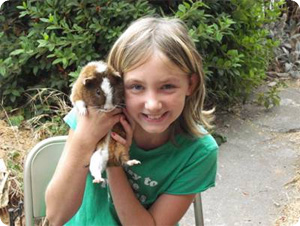GUINEA PIGS

General Information
The Guinea Pig has its origins in the high mountains of South America. Natives of modern day Bolivia, Peru, and Ecuador domesticated the Guinea Pig for use as food. To this day, Guinea Pigs are still raised for food in certain areas of South America.
In the 1600s Spanish sailors were the first to adopt Guinea Pigs as pets and brought them back to Europe from South America. Since that time, Guinea Pigs have been bred to produce a wide variety of types of Guinea Pigs.
These small furry creatures came to be known as “pigs” because of the squeaking noises they make – Guinea Pigs are not related to pigs. The name “Guinea” is believed to have been derived from the route that was traveled to bring these furry animals to Europe – by way of Guinea. Many other cultures throughout the world have also adopted a derivation of the “pig” name for these animals. The scientific name for the Guinea Pig is Cavia porcellus – translated in Latin to mean “little pig.”
GUINEA PIG Scientific Information
Kingdom: Animalia
Phylum: Chordata
Class: Mammalia
Order: Rodentia
Family: Caviidae
Genus: Cavia
GUINEA PIG Character Information
Guinea Pigs are nosey, friendly characters that are easily frightened and always rummaging around for something to nibble on. These furry companions generally weigh between 1 and 3 pounds and can grow up to as big as 15 inches long. The average life span is between 4 and 8 years. Unlike other rodents, Guinea Pigs find a mating partner and stick with that partner throughout their lives.
Guinea Pigs are not as agile as other members of the rodent family – they shy away from jumping, climbing and heights. When they get excited, they will “popcorn” – do little jumps up and down. When necessary, Guinea Pigs will do limited climbing such as going up and down stairs. | |
Other Categories
DOGS
CATS
HORSES
BIRDS
RABBITS
HAMSTERS
MICE AND RATS
GUINEA PIGS
FISH
|

